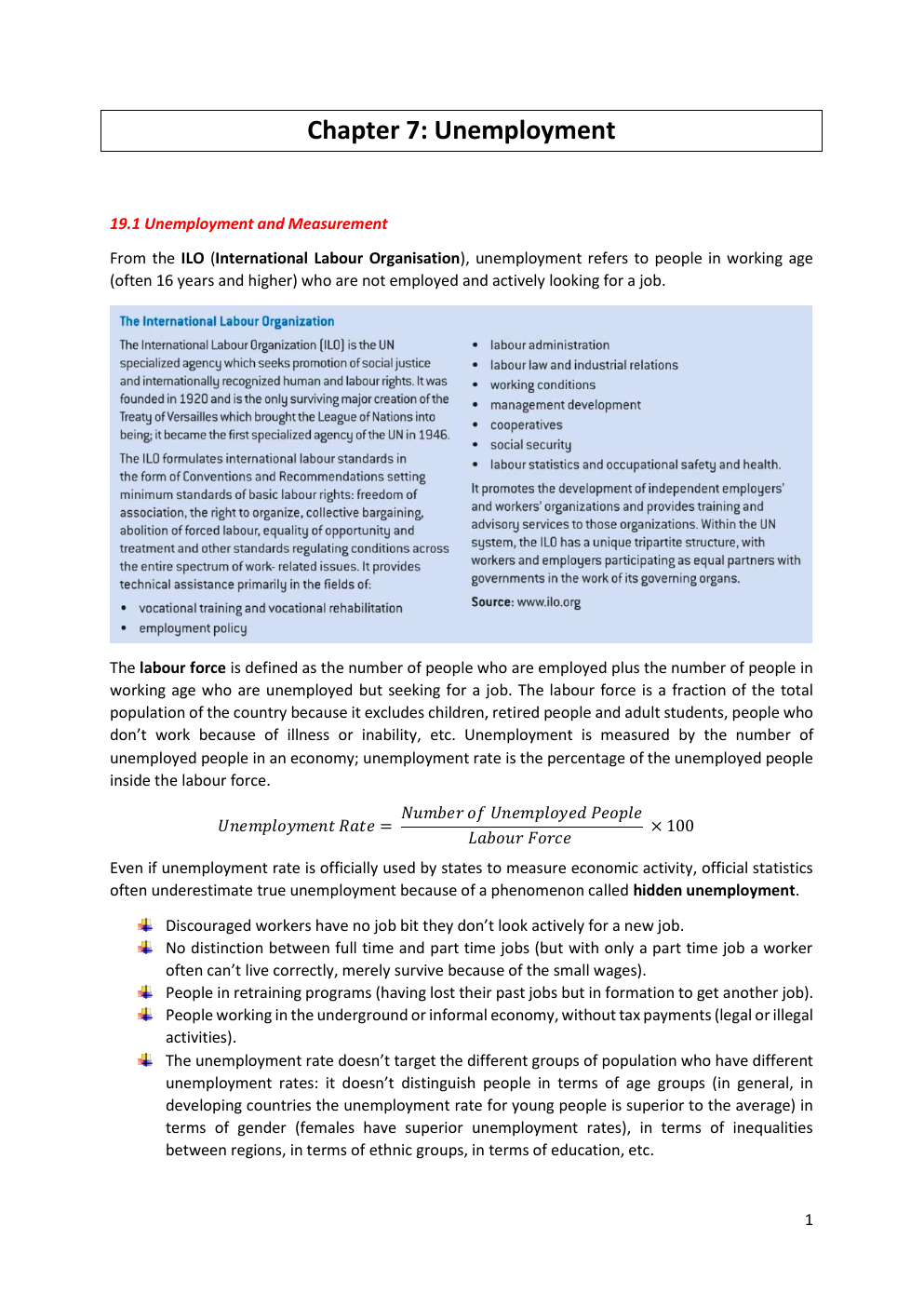Unemployment
Publié le 03/11/2023
Extrait du document
«
Chapter 7: Unemployment
19.1 Unemployment and Measurement
From the ILO (International Labour Organisation), unemployment refers to people in working age
(often 16 years and higher) who are not employed and actively looking for a job.
The labour force is defined as the number of people who are employed plus the number of people in
working age who are unemployed but seeking for a job.
The labour force is a fraction of the total
population of the country because it excludes children, retired people and adult students, people who
don’t work because of illness or inability, etc.
Unemployment is measured by the number of
unemployed people in an economy; unemployment rate is the percentage of the unemployed people
inside the labour force.
𝑈𝑛𝑒𝑚𝑝𝑙𝑜𝑦𝑚𝑒𝑛𝑡 𝑅𝑎𝑡𝑒 =
𝑁𝑢𝑚𝑏𝑒𝑟 𝑜𝑓 𝑈𝑛𝑒𝑚𝑝𝑙𝑜𝑦𝑒𝑑 𝑃𝑒𝑜𝑝𝑙𝑒
× 100
𝐿𝑎𝑏𝑜𝑢𝑟 𝐹𝑜𝑟𝑐𝑒
Even if unemployment rate is officially used by states to measure economic activity, official statistics
often underestimate true unemployment because of a phenomenon called hidden unemployment.
Discouraged workers have no job bit they don’t look actively for a new job.
No distinction between full time and part time jobs (but with only a part time job a worker
often can’t live correctly, merely survive because of the small wages).
People in retraining programs (having lost their past jobs but in formation to get another job).
People working in the underground or informal economy, without tax payments (legal or illegal
activities).
The unemployment rate doesn’t target the different groups of population who have different
unemployment rates: it doesn’t distinguish people in terms of age groups (in general, in
developing countries the unemployment rate for young people is superior to the average) in
terms of gender (females have superior unemployment rates), in terms of inequalities
between regions, in terms of ethnic groups, in terms of education, etc.
1
Calculation
The total population is 35.5 million of inhabitants of whom 17.3 million are in the labour force, 1.5
million work part time even if they would work more, 0.5 million are discouraged workers, and 1.4
million are seeking for work but cannot find any.
What is the unemployment rate?
𝑈𝑛𝑒𝑚𝑝𝑙𝑜𝑦𝑚𝑒𝑛𝑡 𝑅𝑎𝑡𝑒 =
𝑁𝑜𝑛 𝐸𝑚𝑝𝑙𝑜𝑦𝑒𝑑 𝑃𝑒𝑜𝑝𝑙𝑒
1.4 𝑚𝑖𝑙𝑙𝑖𝑜𝑛
× 100 =
× 100 = 8.1 %
𝐿𝑎𝑏𝑜𝑢𝑟 𝐹𝑜𝑟𝑐𝑒
17.3 𝑚𝑖𝑙𝑙𝑖𝑜𝑛
19.2 Consequences of Unemployment
Because unemployment involves economic and social trouble in a society, one of the main objectives
of a government is to reduce it.
Unemployment has both economic and social/personal consequences.
Economic Consequences
-
A loss of real output because all the human resources aren’t deployed (real GDP is inferior to
potential GDP).
It is an under allocation of the labour resource.
-
A loss of income for unemployed workers because social benefits are inferior to normal wage,
and therefore AD is decreasing.
-
A loss of tax revenue and a loss of indirect taxes because of the decrease in consumption.
-
Costs for the government in the form of social benefits.
-
Costs for the government in dealing with social troubles resulting from unemployment (drug
use, criminality, unhappiness and protests, etc.)
-
Increasingly unequal distribution of income.
-
Difficulties in finding work in the future for the unemployed (the greater the time someone is
unemployed, the harder it is to find a job again).
Personal and social consequences
Psychological stress, family tensions, family breakdown, eventual suicide, homelessness, alcoholism,
drug addiction, criminality, etc.
19.3 Types and Causes of Unemployment
Unemployment phenomenon is not a static one, but consists on a permanent flow of inflows and
outflows into a “pool of unemployment”, people gaining employment while other people are
becoming unemployed.
If more people are becoming unemployed than people gain employment, then
the unemployment will rise, and inversely, if more people are gaining employment than people
become unemployed, then the unemployment will fall.
2
The labour market represents the demand and supply for all labour in the economy.
The demand for
labour (or aggregate demand for labour, ADL) includes all the demands for workers wished by the
firms, and the supply of labour (or aggregate supply of labour, ASL) illustrates the total number of an
economy’s workers willing and able to work in the economy at every given average wage rate.
A diagram can show this market, where the x-axis represents....
»
↓↓↓ APERÇU DU DOCUMENT ↓↓↓


